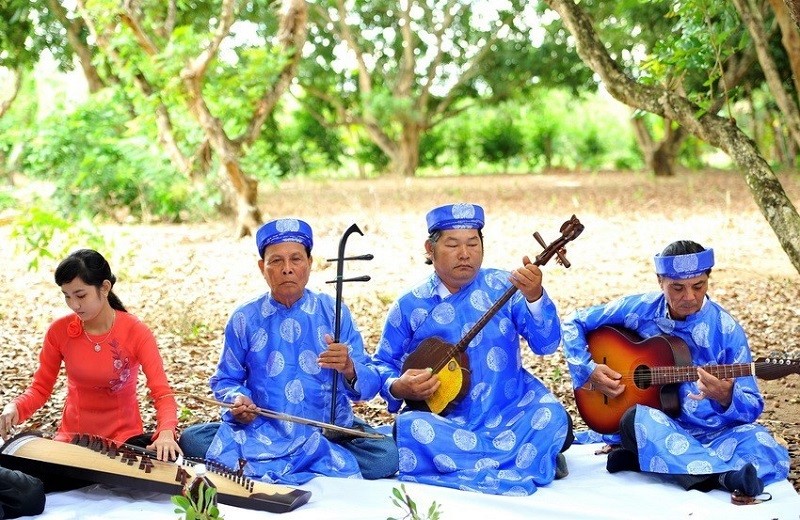
Don ca tai tu: Rising note in national cultural music
Latest
 |
| Don ca tai tu was formed and developed at the end of the 19th century, inspired by Hue royal court music and folk literature, then newly composed on the basis of folk music and duet singing of Southern region. (Source: VNA) |
From labor songs…
Throughout the cause of national construction and defense, generations of Vietnamese people have constantly built, fostered and molded a culture rich in national identity and unity in diversity. The achievements of our ancestors' creation and preservation have left behind a huge and rich treasure of tangible and intangible cultural heritage, including Don ca tai tu.
This is a typical folk art form of the Southern region, originating from the songs that people in rural areas sing after working hours. Musical instruments used for Don ca tai tu are quite diverse such as: pliers, zither, flute, etc. Since around 1930, there have also been concave fret guitar, violin, and Hawaiian guitar.
Don ca tai tu was formed and developed at the end of the 19th century, inspired by Hue royal court music and folk literature, then newly composed on the basis of folk music, duet singing, and rhymes of Southern region. After 1885, Mr. Nguyen Quang Dai, along with many mandarins and royal soldiers, fled to the South to take refuge. With the available knowledge, he compiled a number of musical pieces later becoming typical music genre of the South.
During French invasion’s period, Don ca tai tu encouraged patriotism fighting against foreign invaders, as well as motivated people to resist the influx of Western art. It can be said that Don ca tai tu is not only not replaced by new music genres, but is also a solid support for the development of Cai Luong theater in the future.
Sharing about the value of Don ca tai tu, researcher Bui Trong Hien of the Vietnam Institute of Culture and Arts emphasized that this is the pinnacle of art among Vietnamese string instruments. The number of classic Don ca tai tu songs is up to hundreds. Even though it's the same song, people can play it in many different ways but still comply with general principle of melody. It is the pinnacle of Vietnamese art.
…to national pride
In 2010, the Prime Minister agreed to build a national profile of Don ca tai tu to submit to UNESCO for inclusion in the Representative List of Intangible Cultural Heritage of Humanity. Through many assessment rounds, UNESCO officially recognized Don ca tai tu as an intangible cultural heritage of humanity at the 8th session of the Intergovernmental Committee in Baku, Republic of Azerbaijan on December 5, 2013.
On February 11, 2014, in Ho Chi Minh City, Vietnam held a UNESCO ceremony honoring Don ca tai tu as the intangible cultural heritage of humanity. After ceremony, UNESCO hoped that Vietnam would implement measures to include this intangible cultural heritage in official education program.
This is a vivid demonstration Vietnamese traditional culture's pervasiveness in the integration flow of world culture, creating opportunities for people around the world to enjoy and better understand Vietnamese beautiful culture.
 |
| Chief Representative of the UNESCO Office in Hanoi Katherine Muller Marin awarded a certificate honoring Don ca tai tu as the intangible cultural heritage of humanity in Ho Chi Minh on February 11, 2014. (Source: VnExpress) |
Former Prime Minister Nguyen Tan Dung once emphasized that UNESCO's honor is not only the pride of Vietnamese people, but also a practical contribution to world culture's preservation. Therefore, ministries, sectors, localities and people need to cooperate closely to preserve and develop Don ca tai tu creatively, always having a worthy position in cultural and spiritual life of community.
In addition, Don ca tai tu also follows Vietnamese artists on tours around the world, particularly the efforts of musician Vinh Bao in introducing country's cultural identity to international friends.
In 1971, at the invitation of Southern Illinois University, he went to America as a visiting professor and gave presentation on the quintessence of national art to the world. A year later, he came to France to lecture about Don ca tai tu at the invitation of the Oriental Music Research Center and the Acoustics Center.
In addition, Mr. Vinh Bao and Prof. Dr. Tran Van Khe made a record for Don ca tai tu in collaboration with OCARA Discography and Viet Nam II. He dedicatedly guided foreigners to learn zither and completed many doctoral theses on Don ca tai tu to popularize traditional music to the world. Since then, he is considered the person who laid a solid foundation for UNESCO’s recognition on Don ca tai tu as an intangible cultural heritage of humanity.
















